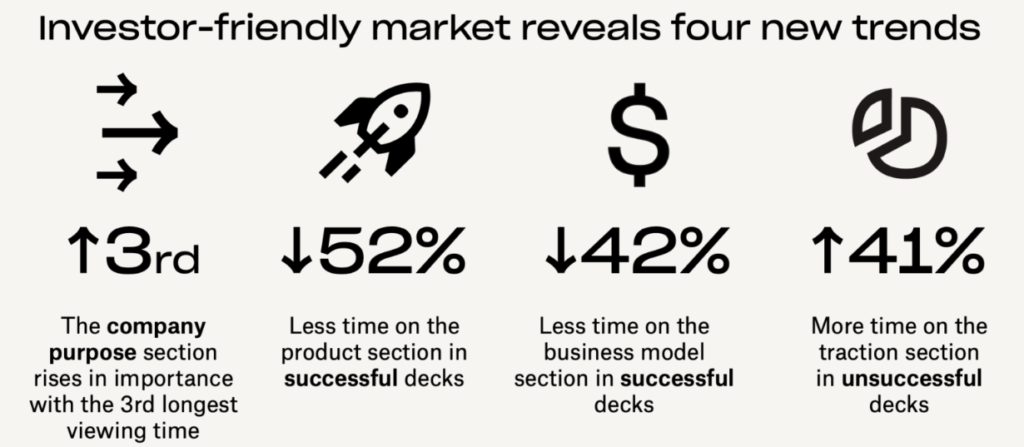“Creating a pitch deck is both an art and a science.” – Dropbox DocSend
In our last blog, we covered how to treat your pitch deck as an art, by including compelling stories and visuals. Today, we’re looking at the science of pitch decks. Dropbox’s DocSend has some of the best research out there on pitch decks. So today, we’ll be exploring some of their stats. This research illuminates the things that currently matter most to venture capitalists (VCs).
We’ll look at overall viewing time, why the order of sections matters, and 4 specific trends they’ve identified.
Overall Viewing Time
In 2021, VCs spent 3 minutes and 32 seconds on average with a pitch deck. In 2022, that time was down to 2 minutes and 42 seconds. A drop of 24%. That means you have about a quarter less time to make an impression with your pitch deck. The most probable reason for the drop in viewing time is the number of pitch decks being sent out. So how you do compete?
By creating a slide deck that balances stories with stats. Jump back to our blog on the art of pitch decks to see how AirBnB raised $600K in their first round of fundraising without showing any numbers or stats on the first 3 slides of their pitch deck. If you have a compelling narrative and strong visuals on your first few slides, you can hook a potential investor and stand out amidst the competition.
Section Order
One of the most interest findings that came out of DropBox’s research involved the order of slides. Let’s check out the difference in successful and unsuccessful presentations.

 Image: DocSend
Image: DocSend
We can draw a couple of conclusions from the differences here.
- Successful decks couch the pitch within a specific time and market as evidenced by their earlier inclusion of the why now and market size slides. This matters to VCs because it continues to build upon story elements and provides a more complete picture of the setting in which their company or product will function.
- Successful decks place the competition slide closer to the end of the pitch which makes sense. They’ve spent the rest of the pitch deck convincing potential investors and clients of their strengths. When the competition slide comes at the end, VCs measure it against all the positives that have come before. When the competition slide comes in the middle of the deck (as it does in many of the unsuccessful decks DropBox studied), VCs don’t have as much to measure it against. For example, they don’t even know who is on the team yet.
- Successful decks wisely place the ask at the end of their pitch. Here’s why. Anyone looking to invest wants all the information first, before they consider coming on board. The unsuccessful decks put the ask before the traction slide, the market size slide, and the team slide. Wouldn’t those all be things you’d want information on before putting money down on the table?
4 Specific Trends
To fully understand the science of pitch decks, we need to know the current trends. Check out these 4 trends DropBox DocSend identified.
 Image: DocSend
Image: DocSend
Trend 1
VCs are spending more time on company purpose. The company purpose is typically your first slide. While some people see it as a “title page” or “deck cover,” this trend proves that VCs are spending more time dissecting them. So it has to be great.
Trend 2
Research found that VCs are spending about half the time on the product section in successful decks than they did in previous years. We think this points to the power of successful decks to tell clear and compelling stories early on. When the problem and solution slides clearly tell the story of how this product will help, the VC is already convinced of its worth by the time the product slide comes up.
Trend 3
Another interesting trend is the drop in viewing time for the business models in successful decks. Look back up at the order of slides in successful decks. You’ll notice that the business model slide comes much later—near the end of the deck. Why does that matter? By the time the VC gets to the business model, he has already seen the team slide. So he knows who he’s investing in. Plus, he understands the potential for traction. So he doesn’t need as much information on the business model and can spend less time on that slide.
Trend 4
The last trend DropBox found was that VCs spent almost twice as much time on the traction section in unsuccessful decks. Again, this makes a lot of sense. The traction slide seeks to directly persuade a potential investor or client that your idea, product, or company can succeed. If VCs spend more time on this slide, it’s because they are looking for more evidence that isn’t there or isn’t strong enough in these unsuccessful pitch decks.
Sure, the pitch deck market is becoming increasingly saturated. But that doesn’t mean you can’t rise above the competition. With knowledge of how successful pitch decks are both an art and a science you can tell the stories VCs want to hear. And you can order the slides in your pitch correctly and cater to current trends.
If you want to know more about how our presentation design experts can take your pitch deck to the next level, get in touch with us now.